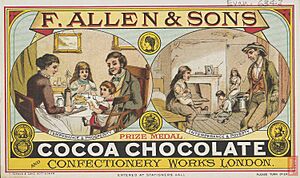Demographics of the Victorian era facts for kids
The Demographics of the Victorian era is about how the population of the United Kingdom changed during the time Queen Victoria was queen (1837-1901). It looks at things like how many people lived there, how many babies were born, and how many people died.
How Britain's Population Changed
The Big Population Boom
Britain was a leader in growing its economy and population very quickly. At one time, a thinker named Thomas Malthus thought that populations would always grow faster than food and resources. This would lead to big problems like famine or war. He called this the 'Malthusian trap'.
However, Great Britain managed to avoid this trap. The amazing scientific and technological discoveries of the Industrial Revolution made life much better. People had more food, cleaner water, and better homes. This meant fewer people died, and people lived longer.
The Victorian era saw a huge increase in Britain's population. It grew from about 13.9 million people in 1831 to 32.5 million in 1901. Two main reasons for this growth were changes in how many babies were born and how many people died.
Britain was the first country to go through a big change called the demographic transition. This change happened because of the Agricultural Revolution and the Industrial Revolution.
Population Growth Across the UK
The number of people in England and Wales nearly doubled. It went from 16.8 million in 1851 to 30.5 million in 1901. Scotland's population also grew fast, from 2.8 million in 1851 to 4.4 million in 1901.
However, Ireland's population actually dropped a lot. It went from 8.2 million in 1841 to less than 4.5 million in 1901. This was mainly because many people left the country and because of the terrible Great Famine.
Why Families Changed Size
An economist named Gary Becker suggested that as cities grew and fewer babies died, families started having fewer children. It became more sensible to spend more on a few children rather than having many. This is known as the first stage of the demographic transition. This trend continued until around 1950.
Birth and Death Rates
Understanding the Demographic Transition
The demographic transition is a shift in how a population changes. It moves from a time when many children die young and many babies are born, to a time when both these numbers are low. Western countries finished this change by the early 1900s.
It happened in two main steps:
- First, fewer children died because of better healthcare, cleaner conditions, and improved food. But families still had many children, which led to a big population boom.
- Later, families started having fewer children.
By 1900, the number of babies who died before their first birthday in England was about 10 percent. This was a big improvement from the Middle Ages, when it was around 25 percent.
Health Improvements and Life Expectancy
The 19th century was the first time England and Scotland did not have a major widespread sickness or famine. The number of deaths per 1,000 people each year in England and Wales fell. It went from 21.9 deaths between 1848 and 1854 to just 17 deaths in 1901.
Your social class also affected how long you lived. Richer people generally lived longer than poorer people in the early 1800s.
Why More Babies Were Born (Initially)
In the Victorian era, the number of babies being born kept going up until 1901. After that, the rates started to level out. There were a few reasons for this:
- Better Health: As living conditions improved, more women were healthy enough to have children.
- More Marriages: In the 19th century, more people got married, and they got married at a younger age. This trend continued until the end of the century, when the average age for marriage slowly started to rise again.
- More Prosperity: One idea is that people had more money. This allowed them to get married and set up new homes earlier than before. When more people marry and have children within marriage, it naturally leads to more births.
Measuring Birth Rates
Birth rates were first measured by the 'crude birth rate'. This was simply the number of births each year divided by the total population. However, this measure was not very detailed. It didn't clearly show the birth rates of specific groups of people.
Later, a better measure called the Net Reproduction Rate was used. This looked at the average number of children women of child-bearing age were having.
Fewer Children, Better Lives
In older times, people often had many children. This was because many children died young, and parents wanted to make sure at least a few would survive. Poorer families often had a reason to limit how many children they had. Richer families didn't feel this need as much because they had more money and fewer children died.
This changed with the Industrial Revolution. Living standards got much better, and fewer people died. People no longer needed to have as many children to ensure some would live to adulthood. The link between being poor and children dying young became weaker.
Overall, health and living conditions improved throughout the Victorian era. Better food and nutrition also played a role in people's health, though how much it helped is still discussed by historians.


